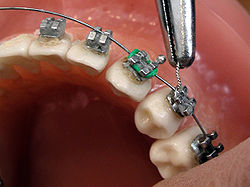 Connecting the arch-wire on brackets with wire | |
| Occupation | |
|---|---|
| Names | Orthodontist |
Occupation type | Specialty |
Activity sectors | Dentistry |
| Description | |
Education required | Dental degree, specialty training |
Fields of employment | Private practices, hospitals |
Orthodontics[a][b] is a dentistry specialty that addresses the diagnosis, prevention, management, and correction of mal-positioned teeth and jaws, as well as misaligned bite patterns.[2] It may also address the modification of facial growth, known as dentofacial orthopedics.
Abnormal alignment of the teeth and jaws is very common. The approximate worldwide prevalence of malocclusion was as high as 56%.[3] However, conclusive scientific evidence for the health benefits of orthodontic treatment is lacking, although patients with completed treatment have reported a higher quality of life than that of untreated patients undergoing orthodontic treatment.[4][5] The main reason for the prevalence of these malocclusions is diets with less fresh fruit and vegetables and overall softer foods in childhood, causing smaller jaws with less room for the teeth to erupt.[6] Treatment may require several months to a few years and entails using dental braces and other appliances to gradually adjust tooth position and jaw alignment. In cases where the malocclusion is severe, jaw surgery may be incorporated into the treatment plan. Treatment usually begins before a person reaches adulthood, insofar as pre-adult bones may be adjusted more easily before adulthood.
Cite error: There are <ref group=lower-alpha> tags or {{efn}} templates on this page, but the references will not show without a {{reflist|group=lower-alpha}} template or {{notelist}} template (see the help page).
- ^ "Definition of orthodontics | Dictionary.com". www.dictionary.com. Retrieved 2019-08-28.
- ^ "What is orthodontics?// Useful Resources: FAQ and Downloadable eBooks". Orthodontics Australia. Retrieved 2020-08-13.
- ^ Lombardo G, Vena F, Negri P, Pagano S, Barilotti C, Paglia L, Colombo S, Orso M, Cianetti S (June 2020). "Worldwide prevalence of malocclusion in the different stages of dentition: A systematic review and meta-analysis". Eur J Paediatr Dent. 21 (2): 115–22. doi:10.23804/ejpd.2020.21.02.05. PMID 32567942.
- ^ Whitcomb I (2020-07-20). "Evidence and Orthodontics: Does Your Child Really Need Braces?". Undark Magazine. Retrieved 2020-07-27.
- ^ "Controversial report finds no proof that dental braces work". British Dental Journal. 226 (2): 91. 2019-01-01. doi:10.1038/sj.bdj.2019.65. ISSN 1476-5373. S2CID 59222957.
- ^ von Cramon-Taubadel N (December 2011). "Global human mandibular variation reflects differences in agricultural and hunter-gatherer subsistence strategies". Proceedings of the National Academy of Sciences of the United States of America. 108 (49): 19546–19551. Bibcode:2011PNAS..10819546V. doi:10.1073/pnas.1113050108. PMC 3241821. PMID 22106280.